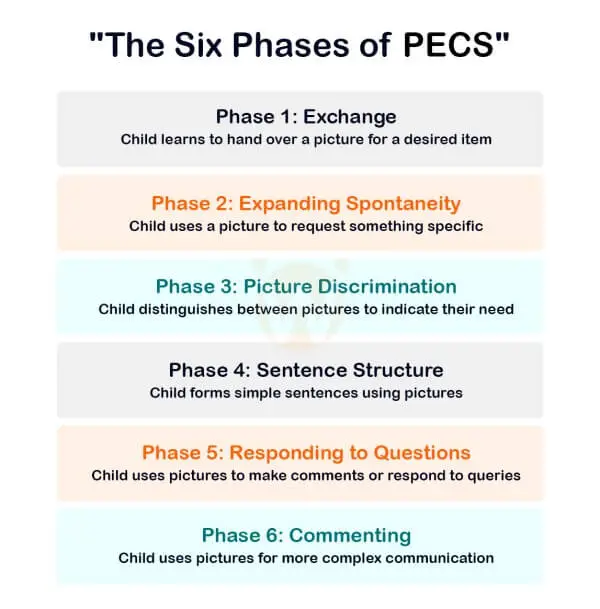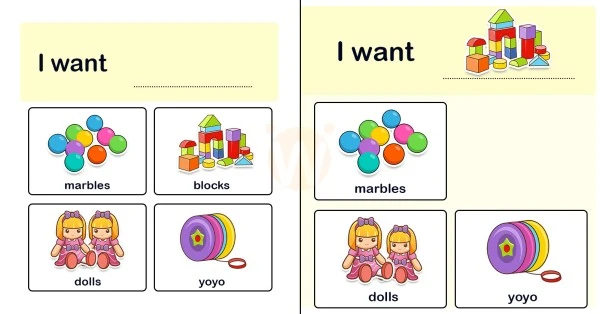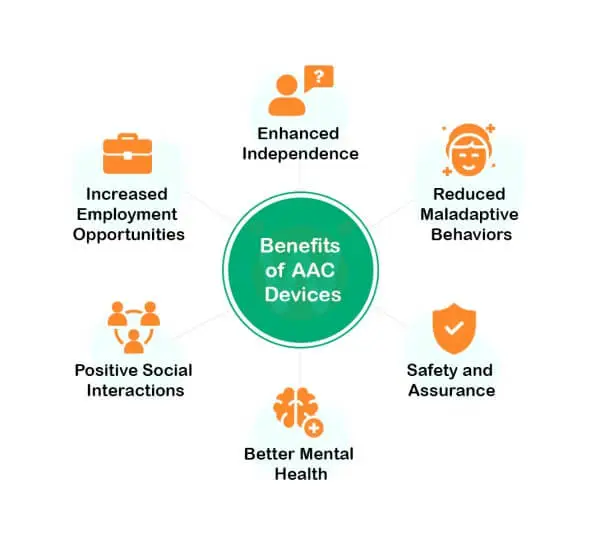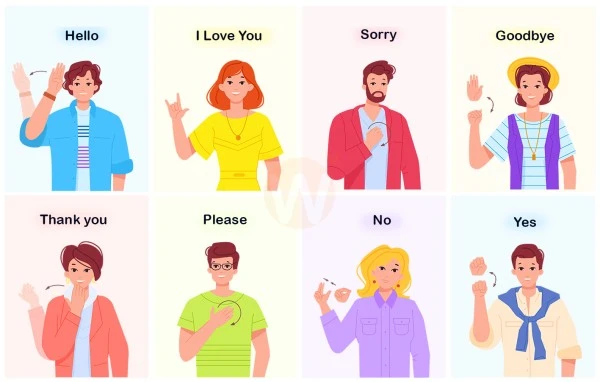Alternative Solutions for Nonverbal Children
By Rajini D
Last Updated: November 24, 2023
Communicating with nonverbal children, particularly those with autism, can be challenging. However, there are various techniques and therapies designed to foster communication in these children. Here are some powerful communication tools for nonverbal children. Let us delve deeper into the details:
Picture Exchange Communication System (PECS):
What It Is

PECS is a well-known communication system that aids individuals with communication challenges. It utilizes pictures to represent words, enabling nonverbal children to express themselves.
Ideal for Whom
This system is especially beneficial for children with autism or other developmental disabilities. It’s simple and intuitive, making it an excellent starting point for children who are just beginning to learn communication methods.
How It Works

Based on applied behavior analysis (ABA), PECS teaches children to use pictures for initiating communication. It’s broken down into six progressive phases:
- Exchange: The child learns to hand over a picture to get a desired item.
- Expanding Spontaneity: The child starts to use a picture to specifically request something they want.
- Picture Discrimination: The child distinguishes between pictures and selects the one that represents their desired item.
- Sentence Structure: The child learns to form simple sentences using pictures, like answering basic questions.
- Responding to Questions: The child uses pictures to make comments or respond to queries.
- Commenting: The child progresses to using pictures for answering more complex questions and expressing thoughts.
Effectiveness
PECS has been proven to enhance communication skills, social interaction, and overall quality of life in children with communication disorders. It’s advisable to consult a speech-language pathologist or a trained professional to determine if PECS is right for your child.
Augmentative and Alternative Communication (AAC)
What is an AAC Device?
AAC devices are tools that help people communicate when they can’t use speech. Just like when you wave to say hello or use gestures, AAC devices assist in conveying messages without speaking. These devices vary widely, from simple picture books to advanced speech-generating devices. They are designed to either replace speech (for those who can’t speak) or supplement it (for those who have limited speech abilities).
Types of AAC Devices
- High-Tech AAC: These include digital devices like iPads, computers with text-to-speech software, and speech-generating devices (SGDs). They offer dynamic and customizable communication options, allowing users to express a wide range of thoughts and needs.
- Low-Tech AAC: This category encompasses tools like picture symbols, communication boards, and picture books. They are typically non-electronic and have static displays, meaning the content doesn’t change dynamically.
- No-Tech AAC: Includes non-digital methods like sign language, facial expressions, body language, and other non-verbal forms of communication. These have been essential for people with communication challenges throughout history.
Benefits of Using AAC Devices

AAC devices are valuable for individuals who struggle with verbal communication due to conditions like autism, cerebral palsy, multiple sclerosis, brain injuries, or other impairments. The benefits are significant:
- Enhanced Independence: AAC devices empower users to express their needs and thoughts independently.
- Reduced Maladaptive Behaviors: By providing a means of communication, AAC can decrease behaviors like aggression or self-harm.
- Safety and Assurance: Knowing they can communicate in emergencies or daily interactions provides a sense of security.
- Improved Social Participation: AAC devices enable better engagement with family, friends, and the community.
- Better Mental Health: Being able to communicate effectively can greatly improve overall well-being and reduce feelings of isolation.
- Positive Social Interactions: AAC users can develop more meaningful social connections.
- Increased Employment Opportunities: Effective communication is key in many work environments, and AAC can open doors to employment for those with speech challenges.
Conclusion
AAC devices play a crucial role in enhancing the quality of life for individuals with communication difficulties. These tools offer diverse options tailored to the needs and abilities of each user, fostering independence, social interaction, and personal expression.
Sign Language
A Visual Language
Sign language is a rich, visual means of communication, where gestures and body language replace spoken words. It’s expressed through hand movements, facial expressions, and body postures.
More Than Just Hand Gestures

While hands play a crucial role, effective sign language communication also relies heavily on eye contact, facial expressions, and body language to convey tone, emotion, and meaning.
Not Just for the Deaf or Hard of Hearing
Primarily used by people who are deaf or hard of hearing, sign language is also embraced by hearing individuals. This includes families and friends of deaf people, interpreters, and those who learn it as a second language.
Rich in Grammar and Structure
Sign language is not a mere collection of gestures. It has its own grammar, rules, and structure, just like any spoken language, and it evolves over time to reflect changes in culture and technology.
Variety and Diversity
There isn’t a universal sign language. Each country typically has its own sign language, reflecting its unique culture and linguistic heritage. For instance, American Sign Language (ASL) differs significantly from British Sign Language (BSL) and Australian Sign Language (Auslan).
Global Diversity
There are over 300 different sign languages used around the world. Each one is a complete language with its own grammar, vocabulary, and idioms.
Widespread Usage
Over 72 million deaf or hard-of-hearing people worldwide use sign language as their primary language, making it a significant mode of communication globally.
Cultural Significance
Sign languages are not just communication tools but are deeply embedded in Deaf cultures. They play a crucial role in the identity and community of Deaf individuals.
Educational and Developmental Benefits
For nonverbal children, including those with autism, learning sign language can aid in developing communication skills, enhancing cognitive development, and providing a foundation for language acquisition.
An Inclusive Tool
Learning and using sign language can promote inclusivity, allowing both nonverbal individuals and the hearing community to engage more fully with each other.
Conclusion
The methods outlined in this article, including PECS, AAC devices, and sign language, are invaluable in enhancing communication for nonverbal children. By providing diverse and tailored communication options, these tools foster greater independence, social interaction, and personal expression. For caregivers and educators, understanding and utilizing these methods can open new pathways for engaging and understanding nonverbal children, thereby enriching their lives and those around them.
FAQ on Communication Methods for Nonverbal Children
1. What is PECS?
PECS stands for Picture Exchange Communication System. It’s a way to help children who don’t speak use pictures to talk about what they want or feel.
2. Who can benefit from AAC devices?
AAC devices are for people who find it hard to speak, like those with autism or cerebral palsy. They help these individuals express their needs and thoughts.
3. Are AAC devices complicated to use?
Not really. AAC devices range from simple picture books to advanced gadgets with speech output. The choice depends on the person’s needs and skills.
4. Can sign language be used by everyone?
Yes, sign language isn’t just for those who can’t hear. It’s a great tool for anyone, including friends and family, to communicate with nonverbal individuals.
5. How does learning sign language help nonverbal children?
Sign language helps nonverbal children by giving them a way to express themselves. It can improve their ability to learn and interact with others.
6. Is it important to consult a professional for these communication methods?
Yes, it’s a good idea to talk to a speech-language pathologist or a trained expert. They can help you choose the best method for your child and teach you how to use it effectively.
7. Can these methods be used at home and in school?
Absolutely! These communication methods can be used both at home and in school, making it easier for children to learn and communicate in different settings.
About the Author:
Rajini,
Speech-Language Pathologist:
Rajini
is a dedicated Speech-Language Pathologist with a focus on developmental speech
and language disorders in children and rehabilitation in adults. With a passion
for helping each individual find their voice, Rajini brings a wealth of
experience and a heartfelt approach to therapy. At Wellness Hub, she’s part of
a team that values innovation, compassion, and results-driven practices.
Book your Free Consultation Today
Parent/Caregiver Info:
Client’s Details:
* Error Message









